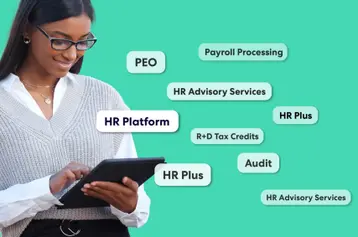All-in-one HRIS Pros and Cons: Is It Right for Your Workplace?

Table of contents
- 1.What are the pros of an all-in-one HRIS?
- 2.Cons of an all-in-one HRIS
- 3.Alternatives to HRIS
- 4.Going with an HRIS
Human resource technology is growing at a dizzying rate. So much so, that North America’s HR tech market is expected to reach $35 billion by 2026. With all the different technologies and software available, it can be a challenge to choose the right HR technology for your business strategy. In this article, we’ll deep dive into the pros and cons of Human Resources Information Systems (HRIS), and explore alternatives.
So, what is an HRIS? In simple terms, an HRIS is a platform that collects, stores and manages employee data. Employee data is frequently used for payroll processing and certain HR tasks, as well as for recruiting and hiring new staff. An HRIS automates and manages the human resources data for these activities within a single comprehensive platform, sometimes referred to as HR software.
What are the pros of an all-in-one HRIS?
Let's look at how an HRIS can offer various HR software features.
- HRIS provides a centralized database for a business to access. It integrates the data so different parts of the system can “talk” to each other. For example, onboarding information can also be used for general HR task management because they all share the same ecosystem.
- This centralization can improve data accuracy and comprehensive analytics within and across different company branches. As a result, HR pros and company executives can get holistic views of the organization's human capital. This view improves their data-driven decision-making and strategic planning.
- Centralization also increases productivity for HR staff and employees. Instead of storing employee information in file folders and envelopes where it's hard to access, HR staff can retrieve it from a central location. HR personnel can also use this all-in-one system to automate otherwise manual processes and make system-wide changes or updates. Most HR-related employee tasks only need to be entered once, and updates occur in one place when employee information changes.
- An HRIS streamlines the hiring process with improved recruiting process. With applicant tracking, soon-to-hires are well taken care of. And HRIS reporting offers quality data analysis for how successful recruitment practices are.
- Automated reminders are another nice perk for HRIS. Company events, performance appraisals, and benefits-related deadlines can all be put on the software’s calendar and sent out automatically.
- Similarly, company documents can be self-hosted through an HRIS. From employee handbooks, procedures, safety guidelines, or training documents, all essential information can live in a central, accessible place.
- Speaking of benefits, an HRIS helps with benefits administration. Employees can enroll, receive notices, and make changes. The HRIS then shares the reported data with your company.
- These systems help with data accuracy. Keeping sensitive employee data secure and private is one of your most essential tasks as an HR professional. There are also data protection regulations that companies may be subjected to. A single HRIS minimizes extraneous entries for potentially sensitive or personally identifiable information across various systems. If you have an HRIS, your system provider can update data across the board.
- It’s also user-friendly. Employees can enter the system to change or retrieve data without involving HR. For example, employees can easily request time off, make benefit elections or update personal information through the centralized system.
Cons of an all-in-one HRIS
- Initial implementation costs may be steep. Any large shift in a company can meet some resistance. There will be upfront training, as well as acquisition and maintenance costs with a new software solution. The high price point may be difficult to shoulder, especially for smaller companies. To make an informed decision, it's essential to evaluate HRIS ROI and costs before implementation.
- In addition to costs, an HRIS still requires in-house HR specialists. Since it's not a fully outsourced HR package, companies may still need a staffed HR department to manage some day-to-day operations.
- HRIS is also less flexible. An HRIS bundles various HR functions and information systems into one solution. Some companies use multiple systems, or point solutions, for different HR functions. This means HR teams using HRIS don't have the opportunity to choose specific solutions for pain points in business processes.
- Similarly, an HRIS might not be powerful enough in key categories. An HR team could have functional systems for payroll processing, benefits administration, and compliance, but their recruiting needs work. In that case, they may need a recruiting solution and HRIS might not do the trick.
- Centralization comes with security risks. Storing all of your key data in one place is great — until it isn’t. For a successful HRIS, all data should be stored securely and IT teams must be proactive in cyber security threat prevention.
Alternatives to HRIS
The key question is what to consider for your business. HRIS is far from the only HR service for small- to medium-sized businesses. With an HR technology comparison, we can explore alternatives to an HRIS for help managing a wide range of HR functions.
Aprofessional employer organization (PEO) is a full-service HR solution for businesses. Certain HR responsibilities are handled by the PEO pursuant to the terms of the contract between the PEO and customer. The PEO is the co-employer and takes on the responsibility for collecting and remitting payroll taxes for their customer employees paid on its platform.
An administrative services organization, orASO, is a service that supports a range of day-to-day HR functions for a small company. However, it may not process payroll or does not report payroll taxes under its own FEIN. An ASO can assist in benefits administration for a company. However, it doesn’t sponsor any health or welfare benefits offered to the client company’s employees.
If a large company has difficulty navigating payroll compliance and finding access to quality benefits, a PEO may be the best fit. Or perhaps a cost-effective solution for a mid-size company could be an ASO, allowing most HR tasks to be supported by the ASO. Individual companies’ size and HR needs ultimately influence which ASO, PEO, or HRIS will be most advantageous and cost-effective.
Going with an HRIS
HRIS can help revolutionize your workforce, big or small. These systems can help manage HR needs, from time and attendance and time off request systems to performance management tools, benefits administration and more. To determine the best fit for your organization, it's helpful to explore the 5 types of HRIS systems and what they offer. The payroll processing is typically streamlined, which can result in a faster and more efficient process and less chance for errors.
As the needs of a business are as unique as the business itself, there is no one-size-fits-all approach. If you're evaluating HR technology options, learn more about how to choose an HRIS that best fits your company’s needs.
Talk to our team members today to learn how TriNet supports small and mid-sized businesses in handling their HR needs.
This communication is for informational purposes only; it is not legal, tax or accounting advice; and is not an offer to sell, buy or procure insurance.
This post may contain hyperlinks to websites operated by parties other than TriNet. Such hyperlinks are provided for reference only. TriNet does not control such web sites and is not responsible for their content. Inclusion of such hyperlinks on TriNet.com does not necessarily imply any endorsement of the material on such websites or association with their operators.

Catherine Tansey
Table of contents
- 1.What are the pros of an all-in-one HRIS?
- 2.Cons of an all-in-one HRIS
- 3.Alternatives to HRIS
- 4.Going with an HRIS






